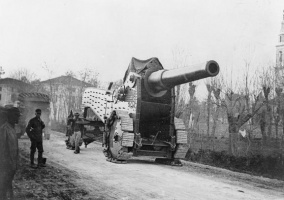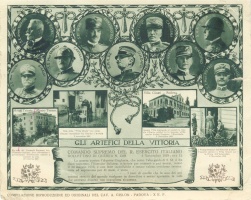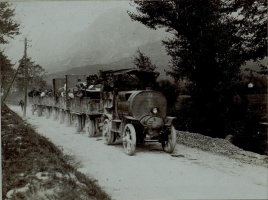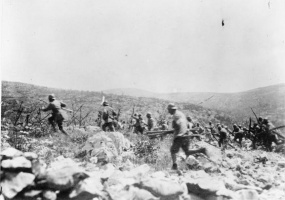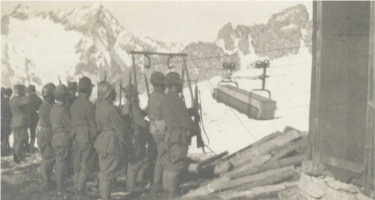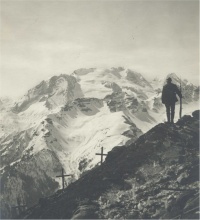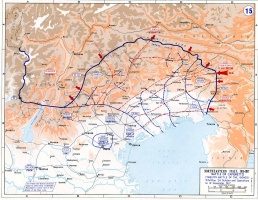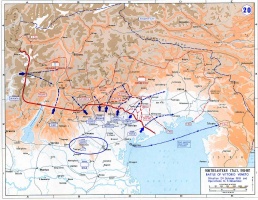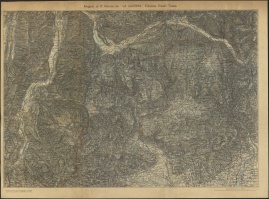Introduction. The Period of Neutrality↑
From 1882, the year of accession to the Triple Alliance, until 1914, the General Staff of the Italian Army avoided considering plans for offensive action against Austria-Hungary. Respect for the alliance with the Central Powers and the clear inferiority compared to Habsburg military power led the Royal Army to limit their planning, as regards to Austria-Hungary, exclusively to initial operations of a defensive nature, apart from short-range surprise actions across the border, aimed at disturbing the assembling of the Habsburg Army.[1]
It was only in August-September 1914, following the declaration of Italian neutrality, that the Chief of Staff Luigi Cadorna (1850-1928)[2] issued the first guidelines for offensive action against Austria-Hungary. The plan, which remained essentially unchanged until May 1915, provided for the main effort to be directed towards the river Isonzo. The Isonzo was the traditional eastern gateway for invading Italy, where the hilly Karst plateau offered greater room for manoeuvring than other border areas with medium and high mountains. Moreover, beyond the Isonzo lay the most important strategic goals, such as Trieste, Ljubljana and the prospect of Vienna. Smaller-scale offensive actions were planned in Cadore and Carnia whose purpose was to sever one of the two main rail arteries that connected Trentino to the Dual Monarchy. In fact, the Trentino salient was the weak point of the Italian line, which, wedged between Lombardy and Veneto just a few kilometres from the Po Valley, was a constant threat to the bulk of the Italian Army stationed in Friuli and therefore threatened with being outflanked. Against this danger, Cadorna deployed an entire army, with primarily defensive tasks, as an offensive in that direction would have been ill-advised both because of the mountainous terrain and the strong development of the permanent defensive structures built by the Austro-Hungarians.[3]
During the ten months of neutrality, the Italian Army was not able to resolve its deficiencies, especially in terms of weapons and equipment, partly due to the limited financial resources destined for the armed forces in peacetime, in comparison to those of the major European powers. Thus, the Royal Army entered the war with a small number of machine guns (about 600), few medium and large calibre cannons (322 pieces), not many artillery shells, and an air fleet composed of a few tens of aircraft. Only the field and mountain artillery were of an adequate number (1,756), while there was such a shortage of Model 1891 Italian 6.5 millimeter caliberrifles, that it was necessary to retrieve, old weapons, Model 1887 Vetterly Italian 10.35 millimeter caliber rifle from the depots.[4]
Therefore, the Italian Army in 1915 was especially strong in manpower (more than 1,000,000 men at the front), but weak in heavy weapons and special equipment. Moreover, industrial conditions also gave cause for concern, with a steel production which amounted to approximately one third of Austria’s. Despite the Libyan war of 1911-1912, in which there was extensive use of field fortifications and passive obstacles, and the information received from the Western Front, where trench warfare had already established itself, the Italian Army was unprepared to face the enemy trenches and barbed wire in June 1915. Thus, waves of infantry assaults clashed against the barbed wire barriers without having valid means for breaching them, such as shells. There was also a lack of hand grenades, which were not distributed to the infantry until the summer of 1915. The failures of that year were also due both to the ubiquitously hilly or mountainous terrain, which favoured the defenders stationed on hills overlooking the Italian lines, and the time the Austro-Hungarians were allowed to fortify their positions in the light of experience gained on the Balkan and Eastern European fronts in nearly a year of war against the Serbs and Russians. It was only in 1916 that, thanks to the supply of French arms and the mobilization of the war industries, the Italian Army was satisfactorily supplied with artillery, munitions and machine guns. Other weaknesses related to the personnel: there was a serious shortage of trained officers, so the organization of minor organic units (companies and platoons) was, from the early stages of the war, left almost entirely to reserve officers trained in two to three months accelerated courses, and there was a high percentage of illiterates among the troops (about one third). Furthermore, the soldiers had a lower patriotic motivation (especially compared to the Germans, French and English) and less cohesive units (with the exception of Alpine troops, who were recruited territorially), due to the national recruitment of the regiments.[5]
The Offensive Operations of 1915↑
Despite these obvious shortcomings, in 1915, the Italian Army showed considerable offensive élan in attacking enemy positions along the whole front line repeatedly and with ardour. Exclusively on the Isonzo between June and November, four major offensives were unleashed which, for insignificant territorial gains, had a high price in human lives. The ratio of two to one in men and artillery could not offset the advantage of the terrain and the defensive structures set up by the Austro-Hungarians. In the first two battles, the losses were 67,000, which equalled those suffered by the enemy, who defended every inch of the ground by launching continuous counterattacks. In the last two so-called "pushes" of the Isonzo in 1915, the Italian losses were almost double the Austrian ones, above all because of the greater strength of the passive defences and the improvement in the organization of field fortifications by the enemy.[6]
There was also little to show for the attacks in the mountainous area of the front, where the Austro-Hungarian defence was further facilitated by the morphology of the soil. Even if the Alps had been crossed countless times by legions of soldiers, until the 20th century, they were rarely the epicentre of bloody battles. Until 1914, no European general staff had envisaged battles between large infantry units on the peaks of high mountains. It was a common opinion among generals that it was only in the plains that decisive battles for the outcome of a war could take place. The troops specialized in mountain warfare, created during the 1800s by some European armies such as the Italian, French and Austro-Hungarian armies, were intended for secondary actions generally as an advance guard, to give the bulk of the army time to mobilize and get in the field. The First World War revolutionized the criteria of the war in the mountains. Not only the locally recruited, specialized troops, equipped and trained to move and be stationed at high altitudes, but also units of line infantry found themselves operating for months on the most inaccessible peaks of the Eastern Alps. At the time, the battles fought between the Italians and the Austrians from 1915 to 1918 on the Adamello and Marmolada glaciers, more than 3,000 metres high, constituted exceptional, never previously recorded events. The exceptional nature of this conflict was due to various morphological, climatic, tactical and logistic factors, which made operations at high altitude all the more difficult. The problems encountered included scarcity and reduced capacity of the roads, slow marches, the presence of numerous unavoidable points of passage, the inaccessibility of extensive areas, difficult climatic conditions, as well as limited water and food resources. In winter, the losses due to frostbite, lightening and avalanches proved to be higher than those recorded in combat.[7]
Although the logistic difficulties were overcome by the extraordinary development of roads and cable cars, rock shelters and hutments and improvements in winter equipment, tactical attempts to overcome the enemy defences, including the recourse to underground mine warfare, were unsuccessful. The occasional local successes obtained in the mountains never reached the goal of breaking through the enemy lines. Instead of manoeuvres to overcome the high-altitude enemy bastions, the Italians resorted to frontal attacks directed against the strongest points of the enemy deployment, which had little chance of success apart from the element of surprise. From the first operations, Cadorna led the army with – perhaps even excessive - firmness, being very severe both with defeated officers or those judged unworthy, and with the troops who showed signs of losing control. To maintain discipline, extensive use was made of coercive methods such as summary executions by firing squad and in some cases even decimations, and it was necessary to significantly increase the number of carabinieri (tripled from 1915 to 1917) assigned to military police duties. During the conflict, military tribunals operated actively, imposing 4,000 death sentences, of which 750 were carried out, as well as numerous summary executions and 15,000 life sentences. 101,000 were convicted of desertion, of which about 6,000 were convicted of going over to, or deserting in the presence of, the enemy.[8]
The Strafexpedition and the Taking of Gorizia↑
In 1916, the Italian Army was able to make up for its losses and increase its strength by a third, to 1.5 million men. There was an even greater enhancement of the artillery, which gained cannons from the fortifications, the navy and the manufacture of new weapons. In particular, the corps of bombers was established to operate the grenade launchers. These were crude weapons, inaccurate and short range, but extremely powerful and destructive. This systematic expansion was not, however, accompanied by an improvement in the training of the infantry, which despite the establishment of marching units, arrived at the line of fire poorly prepared for combat.
In the spring of 1916, the Austro-Hungarian Army launched a major offensive action in Trentino and on the plateaus, aimed at forcing Italy to surrender. Carefully prepared and supported by an impressive array of artillery, mostly medium-heavy pieces, the offensive was on the point of attaining its objective, since, after having broken the forward Italian lines, it succeeded in reaching the last offshoots of the mountains dominating the Plain of Vicenza. The initial success was facilitated by the inadequate Italian defensive deployment, which had massed the bulk of its forces in the forward lines, thus depleting its reserves. Cadorna was able to stem the offensive only with great difficulty and by moving massive reinforcements from the Isonzo Front with the utmost haste, using convoys. The country was deeply affected by what had happened: the government was forced to resign and the position of the Chief of Staff was also in the balance. Threatened by the return of the Italians, who had amassed an entire reserve army, and forced to divert forces to the Eastern Front, where the Russians had broken through the Austrian lines and were streaming towards the Carpathians, the Habsburg command was forced to order a withdrawal to more defensible positions. The Italians tried, without much luck, to pursue the enemy, who succeeded, albeit at the cost of heavy losses, in stabilizing the Trentino front. This so-called "punitive expedition" had cost the Italians 146,000 men, including those killed, wounded and missing in action, and the Austrians 83,000.[9]
Cadorna, however, soon took his revenge, with a wise and rapid manoeuvre through internal lines, by pouring his forces back to the Isonzo. The Austrians, who had weakened that sector in favour of the deployment in Trentino, were not expecting such a sudden Italian offensive recovery. The Austrians were also surprised by the Italians’ impressive concentration of artillery, focusing primarily on the massive use of mortar shells (over 800 pieces), whose preparatory fire swept away the barbed wire and submerged trenches and shelters. Thus, the artillery fire opened the way for the infantry, which in a few hours, conquered bastions hitherto considered impregnable, such as Sabotino, the Podgora and San Michele. Italian troops entered Gorizia, attaining an important objective for the first time. The victory cost 51,000 men against 37,000 enemy losses.[10]
After the Sixth Battle of the Isonzo, the Italian High Command made clear its alignment with the Allies of the Entente in accepting the logic of the war of attrition, which, because of the impossibility of achieving decisive strategic breakthroughs, given the grim Austro-Hungarian defence, aimed at progressively weakening the enemy deployment through continuous offensives. While the Entente guaranteed loans of millions to Italy and the constant flow of supplies by sea (from wheat to coal and steel to horses), the Habsburg Empire suffered greatly from the ban on imports from abroad. Thus, between September and November 1916, Cadorna launched three consecutive offensives on the Isonzo which, although they obtained meagre results on the ground, eliminated 74,000 enemies at the cost of 77,000 Italians. The fact that the losses were nearly equal showed the efficiency of the Italian artillery and the high costs of the advanced defence at all cost, which was imposed by the Austrian command on its units.[11]
The Crisis of Caporetto↑
In the course of 1917, the Italian Army continued to grow in strength, coming to field 2 million men with more than 7,000 pieces of artillery, as well as shells and 12,000 automatic weapons. Aviation had also made significant progress in managing to confront the enemy on equal terms. In May-June, Cadorna unleashed two powerful offensives on the Isonzo (the tenth) and Mount Ortigara. Both were resolved in a stalemate with severe losses: 137,000 Italians against about 80,000 Austrians, who, in the area of Flondar, led a counterattack which managed to wrest some of the ground gained from the Italians, as well as taking 10,000 prisoners.[12]
The great Italian offensives of 1915-1917 consisted of strong attacks preceded by an artillery preparation lasting days that removed the element of surprise and gave the enemy time to send their reserves to the threatened sector. The lack of tanks and the small size of the air force meant having to rely solely on the combination of infantry and artillery for offensive actions. The attacks were carried out by masses of infantry under the cover of artillery fire and generally directed against the strong points, usually high altitude emplacements, of the enemy line. The Italian offensive norms did not include infiltration techniques or attacks at night, while, as regards to defence, resistance to the bitter end on the first or second lines of trenches was favoured. In 1917, however, there was a major tactical-regulatory evolution through the establishment of the first units of assault troops, following the example of the techniques used by and the special training of the Austro-German Sturmtruppen, which were used for sudden attacks and to pave the way for the infantry in the offensives.
The Eleventh Battle of the Isonzo, which was unleashed in August 1917, saw the Italians achieve, for the second time in that area of the front, the breakthrough of enemy lines on the Bainsizza Plateau. However, the pursuit of the retreating Austro-Hungarian troops was slow, allowing them to organize a new defensive line further back which stopped the Italian advance. This total losses were over 240,000 men, a third of whom were Austro-Hungarians. The partial failure disconcerted the Habsburg command, above all because of the high volume of Italian artillery fire: about 5.5 million rounds were fired, including a good proportion of poison gas grenades.[13]
The Austrian command, for fear of not being able to sustain another of Cadorna’s offensives, asked for German help in autumn, which materialized in the sending of seven divisions to take part in a combined Austro-German offensive action in the high Isonzo in the area between Plezzo and Tolmino. The offensive was an overwhelming success for various reasons, including the Italian intelligence service’s underestimation of the preparations observed behind enemy lines and the depositions of several deserters. Another factor was the intensity of the preparation of artillery bombardments, which made extensive use of gas, never previously encountered on the Isonzo front. There were also new fighting techniques, based on infiltration and the search for the enemy's weak points. These were identified, primarily, in the valley floors, which were targeted by the troops of the Central Powers. The result was the retreat of the front to the Piave and the loss by the Italians of more than 300,000 men, for the most part taken as prisoners, 4,850 artillery pieces, 3,000 machine guns and a large quantity of materials and equipment.[14]
After he had recovered from the surprise and the shock of the sudden breakthrough of the defensive lines by the Austro-Germans due to incorrect deployment of the crammed units in the front line and the reserves, Cadorna was able to skillfully conduct a difficult manoeuvre in retreat, using the troops of the 2nd Army, which was the most powerful and largest army, and had ceased to be a fighting force. On the Grappa and the Piave, between November and December 1917, the troops withdrawn from Cadore and the low Isonzo were able to halt any further enemy progression, thus saving the situation. During these decisive battles, in which even the German divisions were blocked, the contribution of the Anglo-French troops (eleven divisions), which had, in the meantime, rushed to Northern Italy, was minimal, and the credit for the victory in the battle of stopping the enemy advance was entirely Italian. Likewise, in Trentino, the Austrian offensive made good progress in reoccupying Asiago, but was stopped as in 1916, before being able to reach the Veneto plain.[15]
The Decisive Battles on the Piave↑
The new Chief of Staff Armando Diaz (1861-1928),[16] who had replaced Cadorna at the beginning of November, intended to carry out a thorough reorganization of the armed forces, starting with the High Command. Cadorna, who had been unwilling to delegate and had not tolerated overly authoritative collaborators, had conceived war plans and directed the war relying almost exclusively on his secretariat, giving a secondary importance to the Information Office and the Operations Unit. Diaz, on the other hand, wanted to give new impetus to group work conducted through consultations with the departments and offices comprising the General Staff. Under Diaz, more willing to trust his collaborators and in favour of team spirit, the High Command excercised its directive prerogatives through the planning and management of operations, including the basic control function, which had been lacking under Cadorna. Cadorna was unable to maintain close control over the four large armies which covered a wide front over 600 kilometers long, as he avoided setting up army group commands.[17]
Diaz, who inherited a much less extensive front line, decided to increase the number of the armies. They would have a smaller and better controlled organic structure, thus avoiding the creation of super armies like the 2nd, which had eight army corps with 670,000 men, and had breached at Caporetto. Diaz restored dignity, responsibility and autonomy of action to each office and department of the High Command, including the post of the Deputy Chief of Staff, who, under Cadorna, had been reduced to dealing with general affairs. Although Diaz proved to be much more collaborative than his predecessor in his relations with the political authorities, he was not very compliant in his relations with his allies: he defended the autonomy of the Italian front and rejected French interference. On the organizational level, Diaz sanctioned the indissolubility of the division, whose components of infantry, artillery, and corps of engineers and services always had to operate in concert and were not to be mixed with other large units, which, had been the norm at the time of Cadorna. This was done in order to improve the amalgam and harmony among the various elements of the various corps, and therefore the combat performance of the division itself. Because of the experience of Caporetto, a general reserve was created. It was at the disposal of the High Command and made up of fresh and efficient troops. It was to serve as a mass counter-offensive manoeuvre to contain any breakthrough of the advanced lines.[18]
Moreover, Diaz also initiated a complete update of the tactical norms, which began to bear fruit in the autumn of 1918. Guidelines for the use of large units in attack and defence were issued, which marked an important step in the evolution of infantry and artillery tactical criteria.[19] Further significant progress was made in the field of the armaments of the infantry, whose units could count on new combat weapons, which significantly increased the ability of penetration and the volume of fire, such as thirty-seven millimeter trench guns, assault flamethrowers, Stokes trench mortars, automatic rifles and SIA light machine guns.[20] Even though in June 1918 the artillery still had not fully made up for the losses incurred at Caporetto, it could make use of a significantly larger number of recently manufactured gun carriage cannons, as well as more modern principles of action accrued on the basis of the experience of Caporetto, which gave great prominence to the counterpreparation barrage in defence. Thanks to the assistance of the British Air Force, the Italian Air Force had by then attained superiority over enemy air forces and also started to perform ground attack missions with fighter planes.[21]
Diaz tried to exhaust his troops as little as possible, only launching offensives on two occasions (the battles of the "Three Mountains" in January 1918, and of Vittorio Veneto). The most well-known aspect of the work done by Diaz was the new attention paid to the morale and welfare of the soldiers, which had been culpably neglected until 1917. The improvement in living conditions became a requirement for commands at all levels. Some improvements were regular and shorter shifts in the trenches, more care given to the preparation of rations, comfortable housing and opportunities for recreation behind the front line, increased leave, free insurance for soldiers and non-commissioned officers, a capillary propaganda service run for the troops by officers assigned to that task, trench newspapers, conferences, etc.
The Italian Army, thus heartened in its morale, flanked by its allies and strengthened in its overall structure, was able to resist the last offensive of the Dual Monarchy in the Battle of the Solstice in June 1918. Everywhere, on the mountainous front of the Plateaus, on the Grappa and the Piave, the Austro-Hungarians, who over-presumptively attacked along the whole of the front line, were repulsed with heavy losses (118,000 against 86,000 Italians). This serious defeat marked the end of any hope of victory on the part of the Habsburg Monarchy. The Italian defence deployed in depth resisted the impact of the enemy, and after an inflection on the Grappa, Montello and the lower Piave, went on the counter-offensive regaining lost ground. Much of the success was due to the skillful use of artillery which in some areas pinned down the enemy infantry before it could join battle.[22]
After having waited in vain for a delivery of tanks and mustard gas from the Allies, on which he had greatly relied to launch a massive offensive, Diaz, urged by the government, which, after the Bulgarian surrender and in light of the incipient political collapse of the enemy monarchy, feared arriving at the peace conference with enemy troops still on Italian soil, decided to attack. The offensive was unleashed at the end of October 1918, and saw, in the first phase, tenacious enemy resistance, which inflicted 28,000 casualties on the Italian forces engaged on the mountainous front. The attack on the Grappa, however, was just a diversionary tactic to divert the enemy's attention from the Piave front where the decisive action took place. After some initial problems due to the river having been swollen by the rains, the breakthrough at the Piave was successful and the Italian troops were able to quickly move forward thanks to the reduced enemy resistance and morale, which had been undermined by the disintegration of the central power in Vienna. After 29 October 1918, the Austro-Hungarian Army began to disintegrate and the Italian troops, almost without opposition, were able to reach the longed-for goals of Trento and Trieste. On 3 November, the armistice was signed in Padua: it went into effect the next day.[23]
In the final battle of Vittorio Veneto, an important role was played by the Assault Army Corps, which constituted the main Italian tactical-systematic innovation of the conflict. Based on two divisions of assault infantrymen (arditi) and a rifle regiment (bersaglieri), they lacked a logistic component and were equipped with small pieces of light artillery, transportable by pack animals. They were reinforced by cavalry regiments, motorcycle units, autocannon groups and light-armoured car squadrons, which played a major part in the pursuit of the routed Austro-Hungarian units. Extensively equipped with mechanical means for transporting troops, the Assault Army Corps was conceived for both rapid, wide-ranging manoeuvres, and for break-through operations with the support of medium and heavy artillery.[24]
Conclusion↑
Although it has not always been justly recognized, especially abroad, Italy’s contribution to the victory of the Entente in the First World War was of great value and, in the last phase of the war, decisive. The conflict on the Italian front depended more on human resources, on the economic and industrial capabilities at the disposal of the opposing sides, than on the operations in the battlefield. Undoubtedly, Cadorna’s offensives on the Isonzo opened the way to victory for Diaz. Vittorio Veneto was the last stage of a long struggle which lasted over forty-one months in which Italy was able to wear down its much more powerful opponent. Austria-Hungary, severely tried in Russia and undermined by its internal problems (the clash between the various nationalities that constituted the empire and wanted self-determination), eventually fell under the impact of the decisive offensive on the Piave and the Grappa in the autumn of 1918.
The Italian war in figures: 5 million enlisted men (out of almost 6 million conscripted), of whom 4,200,000 went to the front; 680,000 dead (including prisoners of war and those who fell ill) and 1 million wounded; 600,000 prisoners (100,000 of whom died); and 600,000 prisoners captured (of whom 180,000 were captured before Vittorio Veneto and 41,000 died).[25] Among the war materials produced were 3,135,000 rifles, 37,000 machine guns, 22,360,000 hand grenades, 7,000 mortars, 16,000 artillery pieces, more than 77 million artillery and mortar shells, over 3.5 billion cartridges, 12,000 airplanes, 52,000 lorries, and 13,000 metric tons of gas.[26]
Filippo Cappellano, Ufficio storico dello Stato maggiore dell’Esercito italiano
Section Editor: Nicola Labanca
Translator: Noor Giovanni Mazhar
Notes
- ↑ L’Esercito Italiano nella grande guerra (1915-1918), vol. II: Le operazioni del 1915, Rome 1929, p. 9.
- ↑ Born in Pallanza on 4 September 1850, he died in Bordighera on 21 December 1928. A Senator of the Kingdom and Marshal of Italy, he was Chief of Staff of the Army from July 1914 until November 1917.
- ↑ Maurizio, Ruffo: L’Italia nella Triplice Alleanza. I piani operativi dello SM verso l’Austria-Ungheria dal 1885 al 1915, Rome 1998, pp. 164-167.
- ↑ L’Esercito Italiano nella grande guerra (1915-1918), vol. I: Le forze belligeranti, Rome 1927, pp. 89-129.
- ↑ Rochat, Giorgio: Ufficiali e soldati. L’Esercito Italiano dalla prima alla seconda guerra mondiale, Udine 2000, pp. 33-49.
- ↑ Montanari, Mario: Politica e strategia in cento anni di guerra italiane, vol. 2: La grande guerra, Rome 2000, pp. 233-245.
- ↑ Isnenghi, Mario/Rochat, Giorgio: La grande guerra 1914-1918, Bologna 2008, pp. 171-174.
- ↑ Guerrini, Irene/Pluviano,Marco: Le fucilazioni sommarie della prima guerra mondiale, Udine 2004, pp. 9-40.
- ↑ Pieropan, Gianni: Storia della grande guerra sul fronte italiano 1915-1918, Milan 1988, pp. 177-193.
- ↑ Pieri, Piero: L’Italia nella prima guerra mondiale, Turin 1965, pp. 195-198.
- ↑ L’Esercito Italiano nella grande guerra (1915-1918), vol. III: Le operazioni del 1916, Rome 1937, pp. 167-262.
- ↑ Faldella, Emilio: La grande guerra, vol. I, Milan 1978, pp. 254-304.
- ↑ L’Esercito Italiano nella grande guerra (1915-1918), vol. IV: Le operazioni del 1917, Rome 1954, pp. 153-398.
- ↑ Dall’Isonzo al Piave 24 ottobre – 9 novembre 1917, Relazione della Commissione d’inchiesta, vol. I: Cenno schematico degli avvenimenti, Rome 1919, pp. 107-372.
- ↑ Ceva, Lucio: Storia delle Forze Armate in Italia, Turin 1999, pp. 136-140.
- ↑ Born in Naples on 5 December 1861, he died in Rome on 29 February 1928. He was Senator of the Kingdom, Chief of Staff of the Army and Minister of War. In 1924 he was appointed Marshal of Italy.
- ↑ Isnenghi, Mario/Rochat, Giorgio: La grande guerra 1914-1918, Bologna 2008, pp. 448-455.
- ↑ L’Esercito Italiano nella grande guerra (1915-1918), vol. V: Le operazioni del 1918, Rome 1980, pp. 64-112.
- ↑ Cappellano, Filippo/Di Martino, Basilio: Un esercito forgiato nelle trincee. L’evoluzione tattica dell’Esercito Italiano nella grande guerra, Udine 2008, pp. 174-182.
- ↑ Manzoni, Cesare/Ricagno, Alessandro: Evoluzione organica dell’Esercito Italiano prima e durante la grande guerra, Turin 1920, pp. 209-233.
- ↑ Di Martino, Basilio: L’aviazione italiana nella grande guerra, Milan 2011, pp. 283-360.
- ↑ Faldella, Emilio: La grande guerra, vol. II, Milan 1978, pp. 347-366.
- ↑ L’Esercito Italiano nella grande guerra (1915-1918), vol. V: Le operazioni del 1918, Rome 1988, pp. 267-994.
- ↑ Di Martino, Basilio/Cappellano, Filippo, I reparti d’assalto italiani nella grande guerra (1915-1918), Rome 2007, pp. 141-202.
- ↑ Ilari, Virgilio: Storia del servizio militare in Italia, vol. 2: La nazione armata (1871-1918), Rome 1990, pp. 443-448.
- ↑ I rifornimenti dell’esercito mobilitato durante la guerra alla fronte italiana (1915-1918), Rome 1924, pp. 237-238.
Selected Bibliography
- Bencivenga, Roberto: Saggio critico sulla nostra guerra, volume 4, Rome 1930: Tipografia agostiniana.
- Bencivenga, Roberto: Saggio critico sulla nostra guerra, volume 2, Rome 1930: Tipografia agostiniana.
- Bencivenga, Roberto: Saggio critico sulla nostra guerra, volume 3, Rome 1930: Tipografia agostiniana.
- Bencivenga, Roberto: Saggio critico sulla nostra guerra, volume 5, Rome 1930: Tipografia agostiniana.
- Bencivenga, Roberto: Saggio critico sulla nostra guerra. Il periodo della neutralità, volume 1, Rome 1930: Tipografia agostiniana.
- Botti, Ferruccio: La logistica dell'esercito italiano, 1831-1981. I servizi dalla nascita dell'esercito italiano alla prima guerra mondiale, 1861-1918, volume 2, Rome 1991: Stato Maggiore dell'Esercito, Ufficio Storico.
- Cappellano, Filippo / Di Martino, Basilio: La guerra dei gas. Le armi chimiche sui fronti italiano e occidentale nella Grande Guerra, Valdagno 2006: G. Rossato.
- Cappellano, Filippo / Di Martino, Basilio: Un esercito forgiato nelle trincee. L'evoluzione tattica dell'esercito italiano nella Grande Guerra, Udine 2008: Gaspari.
- Corpo di stato maggiore (ed.): Le grandi unità nella guerra italo-austriaca, 1915-1918, 2 volumes, Rome 1926: Stato Maggiore dell'Esercito, Ufficio Storico.
- Corpo di stato maggiore (ed.): Riassunti storici dei corpi e comandi nella guerra 1915-1918, 11 volumes, Rome 1924-1929: Stato Maggiore dell'Esercito, Ufficio Storico.
- Di Martino, Basilio: L'aviazione italiana nella grande guerra, Milan 2011: Mursia.
- Di Martino, Basilio: L'aviazione italiana e il bombardamento aereo nella grande guerra, Rome 2013: Ufficio Storico Stato Maggiore Aeronautica.
- Gatti, Angelo, Monticone, Alberto (ed.): Caporetto. Diario di guerra (maggio-dicembre 1917), Bologna 1997: Il Mulino.
- Gibelli, Antonio: La grande guerra degli italiani, 1915-1918, Milan 1998: Sansoni.
- Isnenghi, Mario / Rochat, Giorgio: La grande guerra, 1914-1918, Scandicci 2000: La nuova Italia.
- Manzoni, Cesare / Ricagno, Alessandro: Evoluzione organica dell'esercito italiano. Prima e durante la Grande Guerra, Turin 1920: Scuola di guerra, Ufficio organica.
- Melograni, Piero: Storia politica della grande guerra, 2 volumes, Milan 1997: Laterza.
- Ministero della Difesa (ed.): Dall’Isonzo al Piave, 24 ottobre - 9 novembre 1917. Relazione ufficiale della commissione d’inchiesta di Caporetto, 3 volumes, Rome 1919: Stabilimento poligrafico per l'amministrazione della guerra.
- Ministero della Difesa (ed.): L'Esercito italiano nella grande guerra, 1915-1918, 7 volumes, Rome 1927-1988: Provveditorato generale dello Stato, Libreria.
- Montanari, Mario: Politica e strategia in cento anni di guerre italiane. Il periodo liberale. La Grande Guerra, volume 2, Rome 2000: Stato Maggiore dell'Esercito, Ufficio Storico.
- Pieri, Piero: L'Italia nella prima guerra mondiale (1915-1918), Turin 1973: G. Einaudi.
- Pieropan, Gianni: Storia della Grande Guerra sul fronte italiano, 1915-1918, Milan 2013: Mursia.
- Pluviano, Marco / Guerrini, Irene: Le fucilazione sommarie nella prima guerra mondiale, Udine 2004: Gaspari.
- Procacci, Giovanna: Soldati e prigionieri italiani nella Grande Guerra. Con una raccolta di lettere inedite, Rome 1993: Editori riuniti.





